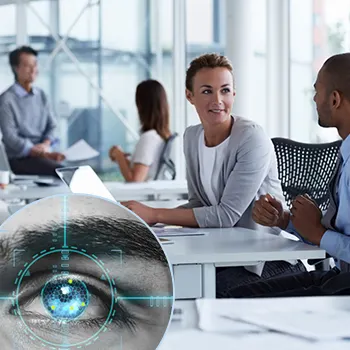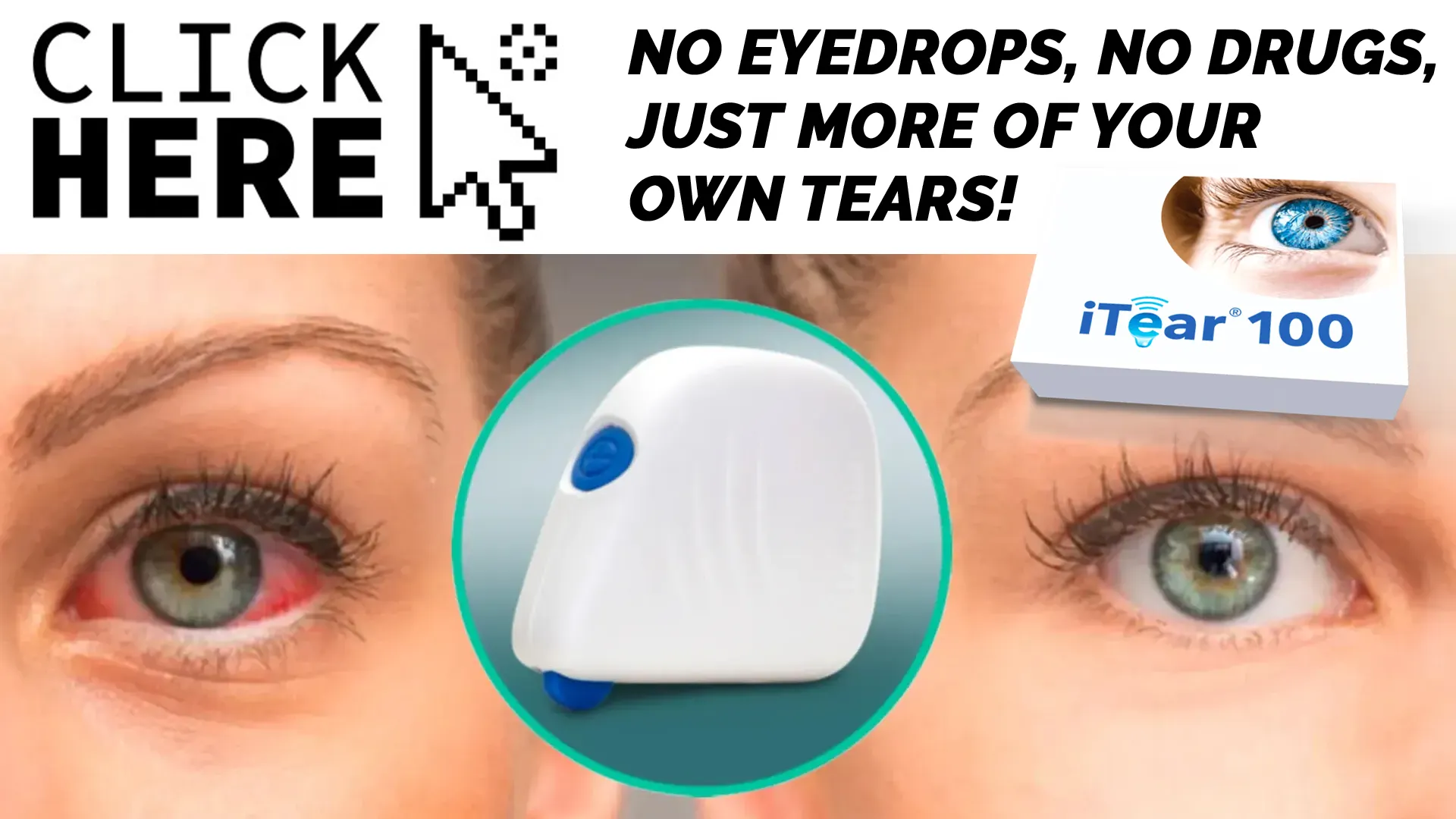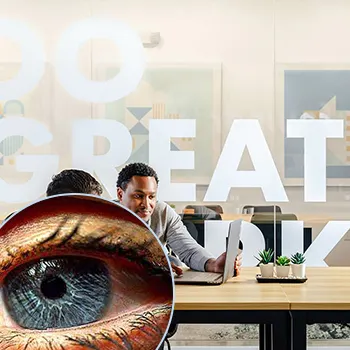Optimizing Eye Care: Computer Jobs and Visual Health Tips
Stop Your Dry Eye Now - Watch the Short Video:
You're here because you have eye irritation or dryness, right? Well, you can stop having that problem. The iTear100 stops your dry eye in just seconds per use, AND you'll need it less as you use it! Visit iTear100.com to learn more!
Table of Contents []
Eye Care Computer Jobs
In today"s digitized workplace, many of us spend countless hours in front of computer screens. The result? An increasing number of employees are experiencing eye strain, dryness, and fatigue. At Olympic Ophthalmics , our mission goes beyond just addressing symptoms-we"re here to empower you with the knowledge and tools needed to protect and nurture your eye health in a comprehensive manner. With our pioneering partnership with Olympic Ophthalmics, inventors of the revolutionary iTEAR100 device, we provide cutting-edge solutions to keep your eyes comfortable and healthy.---
Understanding the Impact of Computer Screens on Your Eyes

Long hours spent staring at a digital screen can cause what"s known as Computer Vision Syndrome (CVS). Symptoms include eyestrain, headaches, blurred vision, dry eyes, and neck and shoulder pain. Our team is here to guide you through simple yet effective strategies to counteract these common computer-related discomforts.
Practicing the 20-20-20 rule can greatly alleviate eye strain. Every 20 minutes, take a 20-second break to look at something 20 feet away. Regular breaks can help reduce the tension on your eye muscles caused by prolonged focusing on your screen.
Monitor positioning is also crucial. The top of your computer screen should be at or slightly below eye level, which helps to reduce strain on your eye muscles and neck. Remember, maintaining a proper ergonomic setup is integral to both eye health and overall posture.
Preventative Eye Care Measures
Preventing eye strain starts with a conscious effort to modify your work environment. Optimizing lighting to reduce glare, using anti-reflective screen covers, and frequently cleaning your monitor can all contribute to minimizing strain on your eyes.
Blinking often is important too. We tend to blink less when focusing intently on screens, which can lead to dry eyes. Make a concerted effort to blink more frequently to moisten your eyes throughout the day.
Eye-Friendly Workstation Tips
A well-set-up workstation can be your first defense against CVS. Position your monitor so that there is no glare from windows or overhead lights, and adjust your screen"s brightness and contrast to a level that feels comfortable for viewing.
According to studies, having your monitor slightly below eye level, not only reduces eye strain but also supports a better head and neck posture.
Adjusting Digital Habits
Your digital habits can have a profound impact on your eye health. Regular breaks using apps or built-in computer reminders can help you enforce healthy habits like the 20-20-20 rule mentioned earlier.
Additionally, reducing blue light exposure before bedtime can significantly improve your sleep quality, as excessive blue light can disrupt natural sleep patterns.
Eye Strain Reducing Exercises
Simple eye exercises can work wonders for relieving tension. Try gently massaging your temples, forehead, and neck to improve circulation and relax the muscles around your eyes. Eye exercises, such as focusing on distant objects after prolonged screen time, can also help maintain your eye health.
Palming, where you warm your hands by rubbing them together and gently place them over your closed eyes, can also be an effective way to rest your eyes during breaks.
---Tackling Dry Eye with Advanced Technology: iTEAR100

One innovative solution to counteract the discomfort of dry and irritated eyes is the iTEAR100. It"s a state-of-the-art, FDA-cleared device that"s been designed to stimulate your own tear production in a natural, drug-free manner.
With the iTEAR100, you can enhance your body"s ability to moisturize and refresh your eyes. Olympic Ophthalmics has paved the way for this technology, allowing easy at-home use that"s both convenient and effective.
To access this groundbreaking device, simply talk to one of our doctors in a streamlined online appointment, upload your prescription, and have the iTEAR100 delivered directly to your door. It"s that simple to take a proactive step towards improving your eye health!
How the iTEAR100 Works
The iTEAR100 operates by gently stimulating a nerve located near your temple. This activation prompts your eyes to produce more natural tears, providing relief from dryness without relying on artificial drops or medication.
The process is quick and user-friendly, making it a hassle-free addition to your daily eye care routine. Consistent use can lead to a noticeable improvement in eye comfort, especially for those in computer-intensive jobs.
Integrating iTEAR100 into Your Routine
Incorporating the iTEAR100 into your daily life is seamless. It"s designed for users with busy schedules and can be used throughout the day whenever your eyes feel dry or tired.
The benefits of natural tear production can"t be overstated-it"s not only about immediate comfort but also long-term eye health. With the iTEAR100, you"re investing in a solution that addresses today"s digital eye strain challenges.
Accessibility and Availability
We understand the need for accessibility and convenience. That"s why the iTEAR100, through us at Olympic Ophthalmics , is available nationwide. Whether it"s new orders or any questions, we can be reached easily at 650-300-9340 .
Empower your vision with technology that supports your eye"s natural capabilities. Contact us today to find out if the iTEAR100 is right for you.
Continuous Support and Care
Our commitment to your eye health doesn"t stop at the point of purchase. Our team is dedicated to providing ongoing support to ensure that you maximize the benefits of your iTEAR100 device.
From troubleshooting to tips for optimal use, we"re here to help you achieve the best possible results for your eye health.
---Stop Your Dry Eye Now:

You're here because you have eye irritation or dryness, right? Well, you can stop having that problem. The iTear100 stops your dry eye in just seconds per use, AND you'll need it less as you use it! Click the image above - get relief now, and finally be free of dry eye issues for good!
Simple Daily Habits for Healthier Eyes

While technology can provide advanced solutions like the iTEAR100, integrating simple habits into your daily routine can also make a significant difference in maintaining healthy eyes in the workplace.
Hydration is key - drinking plenty of water throughout the day can aid in maintaining adequate moisture levels in your eyes, helping to alleviate symptoms of dryness and irritation.
Selecting eye-friendly foods such as those rich in Vitamin A, C, E, Zinc, and Omega-3 fatty acids can also contribute to stronger vision and overall eye health.
Benefits of Staying Hydrated
Beyond keeping your body healthy, proper hydration aids in tear production, which is essential for good eye health. Water plays a pivotal role in carrying nutrients to your eyes and keeping them lubricated.
Try to drink at least 8 glasses of water a day, and remember, if you feel thirsty, you"re already dehydrated!
Dietary Choices That Support Eye Health
Your diet can influence your eye health significantly. Bright-colored vegetables and fruits, like carrots, spinach, and berries, are packed with antioxidants and vitamins beneficial for vision.
Fatty fish such as salmon, mackerel, or sardines are excellent sources of Omega-3, known to support eye health. Flaxseeds and walnuts are good alternatives for vegetarians.
Managing Screen Brightness and Text Size
Adjusting screen brightness to match the surrounding light can prevent your eyes from working too hard. Likewise, increasing text size, especially when reading or writing documents, can reduce squinting and eye strain.
Remember, your eyes should guide your adjustments. If they feel comfortable, you"re on the right track.
The Importance of Regular Eye Check-ups
Regular professional eye examinations are crucial to detect any potential issues early on. An eye care specialist can provide personalized advice and solutions suited to your specific needs and lifestyle.
Even if you don"t have any noticeable symptoms, routine check-ups are a proactive measure for lasting eye health.
Quality Sleep for Eye Rejuvenation
Quality sleep is restorative for your entire body, including your eyes. Ensuring you get enough sleep is essential for maintaining healthy eye function and can help reduce the risk of developing more severe eye conditions.
Creating a sleep-conducive environment by minimizing light and screen exposure before bed can also enhance your sleep quality.
---Prioritizing Eye Breaks and Movement

In any computer-intensive job, taking regular breaks is non-negotiable for both your eye health and overall well-being. Stepping away from your desk not only helps your eyes but also encourages circulation and reduces the risk of long-term musculoskeletal disorders.
Simple stretches, walking, or doing a quick set of exercises can invigorate your body and refresh your vision. Remember to listen to your body"s signals; discomfort is a sign that it"s time for a break.
These breaks are also a great opportunity to practice mindful blinking, which can stimulate natural tear production and prevent dryness.
Setting Reminders for Breaks
Advancements in technology can help us manage our health better. Set alarms or use apps that remind you to take short breaks intermittently throughout your day to rest your eyes.
Consistency is key. Aim to incorporate these breaks into your daily routine for maximum benefits.
Mindful Blinking Exercises
Mindful blinking can help counteract the effects of prolonged screen time. Try to blink every time you hit the "enter" key or finish a paragraph-it"s a small habit that can lead to significant improvements in eye moisture.
Blinking exercises are easy to integrate into your daily routine and can make a notable difference in how your eyes feel at the end of a long day.
Physical Activity for Overall Health
Maintaining physical activity is not only good for your body; it"s also beneficial for your eyes. Increased blood flow and oxygenation as a result of exercise can help to remove toxins and provide nourishment to eye tissues.
Aim for at least 30 minutes of moderate exercise a day, whether it"s a brisk walk or a more intense workout session.
Stretching to Relieve Tension
Neck and shoulder tension can indirectly affect your eyes; tight muscles in these areas can compress the blood vessels supplying your eyes, leading to discomfort. Simple stretching exercises can alleviate this tension and ensure a good supply of blood to your visual organs.
Incorporate neck rolls, shoulder shrugs, and arm stretches into your breaks to promote circulation and relaxation.
Creating a Balanced Work Routine
A balanced work routine is about managing your tasks efficiently while also prioritizing your health. Alternate between tasks that require intense visual focus and those that allow your eyes to rest.
This balance ensures you"re not putting constant strain on your eyes and helps prevent the onset of CVS-related symptoms.
---Ergonomic Adjustments for Enhanced Eye Health

Ergonomics is often associated with posture and comfort, but it has significant implications for eye health too. Adjusting your workspace to suit your personal needs can reduce strain on your eyes and improve your overall work efficiency.
Investing in an adjustable chair and desk can support the ideal monitor height and distance, ensuring you"re in the best position to minimize eye strain. The angle of your screen can also have a profound effect, so be sure to adjust it to eliminate glare.
Properly positioned equipment can decrease the likelihood of experiencing symptoms of CVS and contribute to a more productive work environment.
Chair and Desk Positioning
Your chair should provide proper lumbar support and allow your feet to rest flat on the ground. A desk that allows you to comfortably reach your keyboard and mouse without overextending will help maintain a relaxed posture, reducing strain on your eyes.
Ensure your monitor is approximately an arm"s length away, and the top of the screen is at eye level or slightly below for optimal comfort.
Monitor Angle and Distance
Position your screen so that your gaze is slightly downward, between 15 and 20 degrees. This angle helps promote a more natural eyelid closure and can reduce the rate of tear evaporation.
If you have multiple monitors, position them so you can easily transition your gaze from one to the other without excessive head movement.
Lighting and Glare Reduction
Excessive lighting or glare can cause eye fatigue. Position your monitor away from direct lights and utilize blinds or shades on windows as necessary. Dimming overhead lighting and using task lamps with diffusers can also create a more eye-friendly environment.
You might also consider using a glare filter over your screen if glare continues to be a problem.
Keyboard and Mouse Ergonomics
Your keyboard and mouse play a role in your overall comfort. Make sure they are positioned in such a way that your wrists are in a neutral position to avoid strain on your arms and shoulders, which can additionally affect your neck and eyes.
Wrist rests are a simple addition that can greatly improve your typing and navigating comfort.
Personalizing Workspace Lighting
The intensity and color temperature of your lighting can influence how your eyes respond throughout the day. Personalize your workspace lighting to find the balance that works best for your eyes, reducing the likelihood of strain and headaches.
Soften bright lights when possible, and choose bulbs that provide a warm spectrum of light for a more calming visual environment.
---Visual Hygiene for Digital Professionals

Visual hygiene is a term we use to encompass all the practices that keep our eyes healthy in a digital-focused world. Regular cleaning of your screen to remove dust and smudges not only helps you see your work clearly but also prevents your eyes from straining.
Adjusting font size and color contrast on your devices can make a significant difference, as well. Larger text and higher contrast can reduce the effort required to read, thereby lowering the likelihood of eye strain.
It"s also essential to be mindful of your blinking habits, as this natural reflex plays a crucial role in keeping the eyes moisturized and clearing away irritants.
Screen Cleanliness and Maintenance
A clean screen is essential for clear vision. Use a soft, slightly dampened cloth to wipe away fingerprints and dust from your screen, and do it on a regular basis to ensure that you"re not straining to see through blemishes on the display.
Avoid harsh chemicals or abrasive materials that can damage the screen"s surface.
Optimizing Font Size and Contrast
Your computer and smartphone have settings that allow you to adjust font size and color contrast to reduce eye strain. Experiment with these settings to find a comfortable reading environment for your eyes.
Remember that what"s comfortable for one person may not be ideal for another, so personalize these settings based on your own visual comfort.
The Role of Blinking in Eye Health
Blinking is a powerful tool for maintaining eye health. It refreshes the eyes and helps distribute protective and nourishing tears across the surface of the eye. Consciously making an effort to blink more often, especially when using digital devices, can be highly beneficial.
Be intentional with your blinking, especially when engaged in long sessions of screen time. Consider it an essential part of your visual hygiene routine.
Embracing Minimalist Screen Design
When it comes to digital content, less can be more for your eyes. Opt for clean, uncluttered layouts in the programs and apps you use regularly. This minimalist approach can minimize visual noise, making it easier for your eyes to focus on the task at hand.
Seek out designs that use plenty of white space and clear, readable fonts to ease the visual load on your eyes.
Importance of Regular Cleaning Routines
Develop a routine for keeping your workspace and digital devices clean. This not only applies to screens but also keyboards, mice, and even your glasses if you wear them. A clean work environment contributes to better eye health and optical clarity.
Making this a habitual part of your day can make a significant difference in your visual comfort.
---Recognizing and Addressing Eye Discomfort

While preventative measures are key, it"s equally important to recognize the signs of eye discomfort and address them promptly. Symptoms like redness, itchiness, or a gritty feeling are alerts that your eyes need attention and potentially a break from screen time.
Seeking professional advice for persistent discomfort is essential to prevent long-term damage. Our team at Olympic Ophthalmics is always ready to assist you and provide solutions tailored specifically to your needs.
Being proactive about your eye health can prevent many issues associated with prolonged computer use. If you experience discomfort, don"t hesitate to reach out to us at 650-300-9340 .
Signs of Eye Strain to Watch For
Common signs of eye strain include headaches, blurred vision, difficulty concentrating, and increased sensitivity to light. If you notice these symptoms, it"s a sign to take a step back and assess your eye care habits.
Adopting the eye care tips discussed earlier can alleviate these symptoms and contribute to more comfortable screen use.
Immediate Actions to Relieve Eye Discomfort
If you"re feeling discomfort, there are immediate actions you can take. Closing your eyes for a few minutes, blinking rapidly to encourage tear production, or using warm compresses can provide quick relief.
It"s also beneficial to take short, frequent breaks to give your eyes a rest from the constant demands of focusing on a screen.
Professional Help and When to Seek It
If simple remedies aren"t relieving your symptoms, it may be time to seek professional help. An eye care specialist can conduct a comprehensive examination and offer specialized treatments or adjustments to your eye care regimen.
Don"t ignore persistent discomfort-early intervention can prevent more serious problems down the line.
Using Technology with Eye Health in Mind
When using digital devices, always keep eye health in mind. Adjust your device settings as needed and utilize technologies designed to reduce eye strain, such as the iTEAR100 or blue light filters.
Technology can be a fantastic tool when used thoughtfully and with attention to its impact on your eyes.
